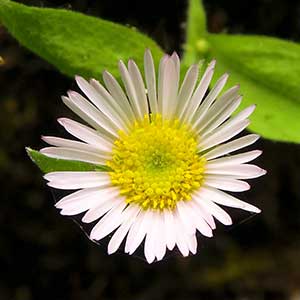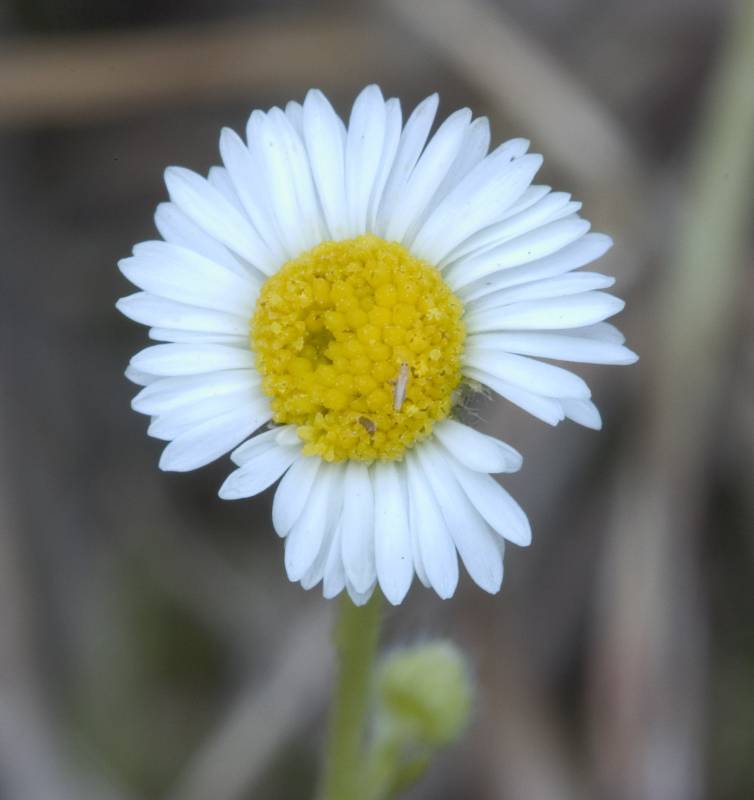|
Gorge fleabane, Oregon fleabane
|
branched fleabane, daisy fleabane
|
| Perennial from a stout, woody base and root, the lax stem 5-15 cm. long, covered with glands and loose, sticky hairs. |
Mostly annual, 3-7 dm. tall, with scanty foliage. |
Basal leaves tufted, spatulate to obovate, coarsely toothed or incised, up to 9 cm. long and 2.5 cm. wide; cauline leaves well developed, broadly lanceolate to ovate or elliptic, up to 4 cm. long and 1 cm. wide. |
Leaves all cauline, entire, linear to lanceolate. |
Heads 1-several in a leafy inflorescence, the disk 9-13 mm. wide; involucre 5-7 mm. high, the bracts loose, equal, thin and green; rays 30-60, pink or white to bluish; disk corollas 3.4-4.7 mm. long, yellow; pappus simple, of 15-20 bristles that are curled and twisted above. |
Heads several to numerous, small; involucre 2.5-5 mm. high, hairy and somewhat glandular; rays 50-100, pistillate, white, up to 6 mm. long and 0.4-1 mm. wide; disk corollas 1.5-2.6 mm. long, yellow; pappus of 10-15 very fragile bristles and some short, slender scales, the bristles wanting in the ray flowers. |
|
|
|
|
| May-September |
May-October |
| Moist shady cliffs and ledges. |
Roadsides, fields, thickets, forest edge, and other open, disturbed areas from low to middle elevations. |
Occurring in the Columbia River Gorge in Washington; Columbia River Gorge in Washington to adjacent Gorge area in Oregon.
|
Occurring on both sides of the Cascades crest and in the Columbia River Gorge in Washington; British Columbia to California, east to the Atlantic Coast.
|
| Native |
Native |
| Threatened in Washington (WANHP) |
Not of concern |
E. acris, E. aliceae, E. annuus, E. aureus, E. basalticus, E. bloomeri, E. caespitosus, E. chrysopsidis, E. compositus, E. corymbosus, E. davisii, E. disparipilus, E. divergens, E. eatonii, E. elatus, E. filifolius, E. flettii, E. glacialis, E. howellii, E. inornatus, E. karvinskianus, E. leibergii, E. linearis, E. lonchophyllus, E. nivalis, E. peregrinus, E. philadelphicus, E. piperianus, E. poliospermus, E. pumilus, E. salishii, E. speciosus, E. strigosus, E. subtrinervis |
E. acris, E. aliceae, E. annuus, E. aureus, E. basalticus, E. bloomeri, E. caespitosus, E. chrysopsidis, E. compositus, E. corymbosus, E. davisii, E. disparipilus, E. divergens, E. eatonii, E. elatus, E. filifolius, E. flettii, E. glacialis, E. howellii, E. inornatus, E. karvinskianus, E. leibergii, E. linearis, E. lonchophyllus, E. nivalis, E. oreganus, E. peregrinus, E. philadelphicus, E. piperianus, E. poliospermus, E. pumilus, E. salishii, E. speciosus, E. subtrinervis |
|
|
| |
BC,
OR,
WA
Flora NW,
PNW Herbaria
WildflowerSearch
iNaturalist (observations)
USDA Plants Database



